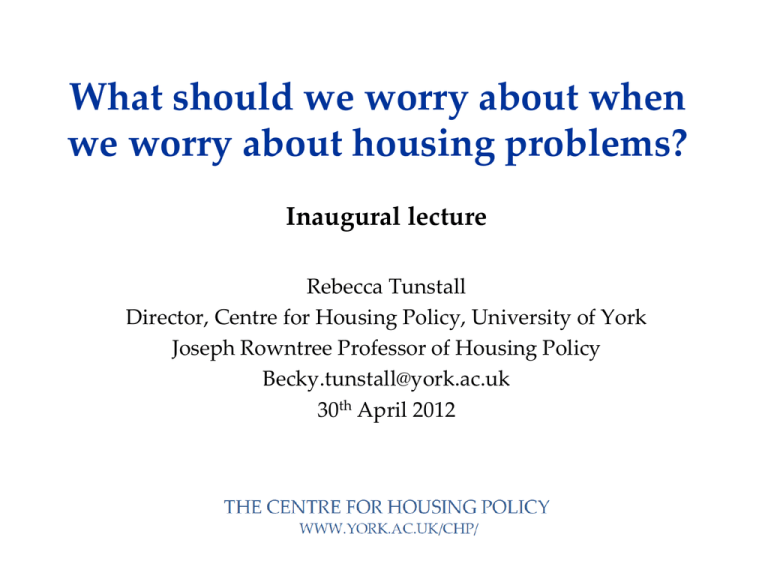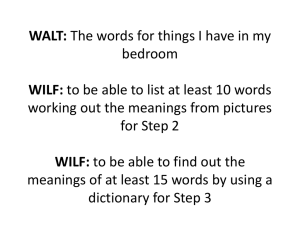
What should we worry about when
we worry about housing problems?
Inaugural lecture
Rebecca Tunstall
Director, Centre for Housing Policy, University of York
Joseph Rowntree Professor of Housing Policy
Becky.tunstall@york.ac.uk
30th April 2012
sweets
3
Introduction
• There are strong arguments for worrying about housing
consumption in relative rather than absolute terms, where data and
measures allow
• This lecture presents a case study of relative housing consumption,
measured via housing space
Using a long-term perspective, and relative measures, it argues that:
1. We need to reassess assumptions about past achievements on
overcrowding
2. Housing space inequality are similar to inequalities in income, and
by some measures are growing
3. New space supply and demand problems appear to have emerged
over the past 30 years
4. Current policy will exacerbate inequalities, and old-fashioned
absolute problems are on the increase.
4
An experiment...
Place A
Place B
The average home has 6
rooms
Your new home has 2 rooms
The average home has 1
Your new home has 3 rooms room
5
Absolute housing space standards
‘Overcrowding’
• Households with fewer than 0.5/1/1.5 rooms per person (C19th-)
‘Bedroom standard’ (1960-)
A bedroom for:
• Each married/cohabiting couple;
• Any other person aged 21+;
• Any pair aged 10-20 of the same sex;
• Any pair aged under 10.
Basis fore most social rented allocations today (Pawson et al. 2009)
8
Arguments for worrying about housing
space consumption in relative terms
1.
More socially just?
2.
Relative standards accepted by experts and public for income;
no reason not to apply to consumption too
3.
Housing appears to be partly a ‘positional good’ (Bramley et al.
2008, Marsh and Gibb 2011)
4.
Housing is important in social science partly because of role of
housing inequality in stratification (Rex and Moore 1967, Bell
1977, Saunders 1990, Hamnett 1999, Malpass 2005)
5.
Current absolute standards challenged:
“very low… now generally accepted as being completely
unacceptable” (ODPM 2004 npn)
9
Data and measures used here
Census of population, 1911-2001
England and Wales
‘Rooms’ = “count the kitchen as a room, but do not count scullery, landing,
lobby, closet, bathroom, nor warehouse, office, shop” (GRO 1913 p2).
1-bed flat with kitchen and living room = 3 rooms
3-bed house with kitchen, 2 living rooms = 6 rooms
•
•
•
•
•
•
Does not account for room size or type
Applied to individuals not households
Treats all individuals the same way: no equivalisation
Excludes ‘non household’ population
Excludes second homes
No 2011 data yet
Absolute low consumption
- ‘overcrowding’ – fell dramatically
Percentage of people in households with less than one room per
person, England and Wales, 1911-2001
Median housing space per person rose steadily
Rooms per person
4
3.5
Roooms per person
3
2.5
2
1.5
1
0.5
0
1911
1921
1931
1951
1961
1971
1981
1991
2001
But experiences varied across the population
Rooms per person by population decile
4
3.5
Rooms per person
3
2.5
2
1.5
1
0.5
0
1911
1921
1931
1951
1961
1971
1981
1991
2001
There was no change in housing space
inequality according to the Gini measure
0.40
0.35
0.30
0.25
0.20
0.15
0.10
0.05
0.00
1911
1921
1931
1951
1961
1971
1981
1991
2001
Ratios show falling and then rising
inequality
5
4
3
2
1
0
1911
1921
1931
1951
90:10 ratio
1961
1971
1981
1991
50:10 ratio
2001
Percentage of people below 60% median
space shows the same trends
25%
20%
15%
10%
5%
0%
1911
1921
1931
1951
1961
1971
1981
1991
2001
16
Potential causes
of rising housing space inequality
1.
2.
3.
4.
Household-home size mismatch
Blockage of ‘trickle down’ of space
Income inequality?
Tenure change?
Increasingly, small households were wellhoused due to a deficit of smaller homes
1-person households with 4+ rooms
10%
Percentage of total population
9%
8%
7%
6%
5%
4%
3%
2%
1%
0%
1911
1921
1931 1951
1961
1971 1981
Due to deficit of smaller homes
Other
1991
2001
The best-housed gained more
from new development, especially after 1991
Percentage of net additional rooms held by different groups
40%
35%
30%
25%
20%
15%
10%
5%
0%
1921-81
Best housed tenth
1981-91
Middle
1991-2001
Worst housed tenth
Housing space inequality shows
similar trends to income inequality
90:10 and 50:10 ratios
5
4
Ratios
3
2
1
0
1911
1921
Rooms 90:10
1931
1951
Income (AHC) 90:10
1961
1971
Rooms 50:10
1981
1991
2001
Income (AHC) 50:10
Is there a link between relative housing space
and housing tenure?
Tenure composition of fifths of population by housing space,
2001
100%
90%
80%
70%
60%
50%
40%
30%
20%
10%
0%
Best housed fifth
4th
Owners
Middle
Social renters
2nd
Private renters
Worse housed fifth
21
Potential consequences of rising inequality
1. Reduced happiness, well-being?
2. Sustained or increased absolute low consumption?
Implications:
• Monitoring via relative standards
• New development?
• Redistribution?
22
Potential relative housing space standards
‘Low relative housing space consumption’ standard:
• Below 60% median housing space
• In 2001, below 1.9 rooms per person - generally above bedroom
standard
‘Consensual’ standard (Bradshaw et al. 2008):
• Pensioner couple – 2 bedrooms - bedroom standard +1
• All children – own room - probably above bedroom standard
23
The 1960 bedroom standard is “now generally accepted as being completely
unacceptable” (ODPM 2004 npn)
It places most individuals:
• In worst housed fifth for 2001
• Below 60% median space
• Below consensual standard
• At what median person had achieved by 1921
24
The strange re-emergence
of the politics of housing space
New space policies:
1. The single room rent and extension – puts people below the
bedroom standard
2. The ‘benefit cap’ – may be at/below bedroom standard
3. The ‘bedroom tax’ – at bedroom standard
Significant reduction in welfare rights
Regressive redistribution of space?
Likely to result in increase in old-fashioned overcrowding
25
Conclusion
There are strong arguments for worrying about housing consumption
in relative rather than in absolute terms, where data and measures
allow
Relative measures suggest:
1. We need to reassess assumptions about past achievements on low
housing space: overcrowding could have been reduced faster
2. Housing space inequality are similar to inequalities in income, and
by some measures are growing
3. New structural space supply and demand problems appear to have
emerged over the past 30 years: size mismatch, trickle down
blockage
Current policy will exacerbate inequalities, and old-fashioned absolute
problems may be on the increase.
26
References
Bell, C. (1977), ‘On housing classes’ Journal of Sociology 13(1):36-40
Bradshaw, J.; Middleton, S., Davis, A., Oldfield, N., Smith, N., Cusworth, L., and Williams, J, (2008), A
minimum income standard for Britain: What people think, York, JRF
Bramley, G., Leishman, C. and Watkins, D. (2008) Understanding neighbourhood housing markets:
regional context, disequilibrium, sub-markets and supply; Housing Studies 23(2) pp179-212
Hamnett, C. (1999), Winners and losers: Home ownership in modern Britain, London, UCL
Malpass, P. (2005), Housing and the welfare state: The development of housing policy in Britain, Basingstoke,
Palgrave Macmillan
Marsh, A and Gibb, K (2011) ‘Uncertainty, expectations and behavioural aspects of housing market
choices’, Housing, Theory and Society, 28(3), pp215-235
Office of the Deputy Prime Minister (2004), Overcrowding in England: The national and regional picture:
Statistics, London, ODPM
Pawson, H., Brown, C. and Jones, A. (2009) Exploring local authority policy and practice on housing
allocations, London: Communities and Local Government
Rex, J. and Moore, R. (1967), Race, community and conflict: A study of Sparkbrook, Oxford: Oxford
University Press
Rowntree, B. S. (1901), Poverty: A study of town life, London, Macmillan and Co.
Rowntree, B. S. (1985), Poverty and progress, New York, Garland Publishers
Saunders, P. (1990), A nation of home owners, London, Allen and Unwin
Stephens, M., Fitzpatrick, S., Elsinga, M., van Steen, G., and Chzhen, E. (2010), Study on housing
exclusion: Welfare policies, housing provision and labour markets, Brussels, European Commission
Woolf, V. (1991), A room of one’s own London, Hogarth Press.
27
For more information:
www.york.ac.uk/chp
Becky.tunstall@york.ac.uk








